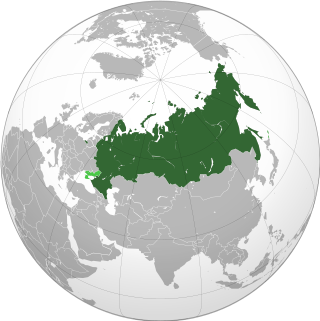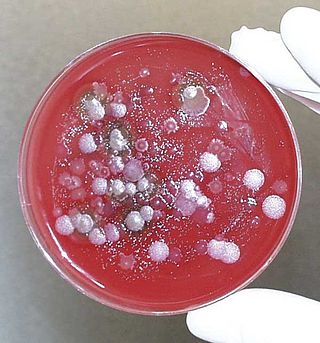Related Research Articles

Biological warfare, also known as germ warfare, is the use of biological toxins or infectious agents such as bacteria, viruses, insects, and fungi with the intent to kill, harm or incapacitate humans, animals or plants as an act of war. Biological weapons are living organisms or replicating entities. Entomological (insect) warfare is a subtype of biological warfare.
The All-Union Science Production Association Biopreparat was a Soviet agency created in April 1974, which spearheaded the largest and most sophisticated offensive biological warfare program the world has ever seen. It was a vast, ostensibly civilian, network employing 30–40,000 personnel and incorporating five major military-focused research institutes, numerous design and instrument-making facilities, three pilot plants and five dual-use production plants. The network pursued major offensive research and development programs which genetically engineered microbial strains to be resistant to an array of antibiotics. In addition, bacterial agents were created with the ability to produce various peptides, yielding strains with wholly new and unexpected pathogenic properties.

The Biological Weapons Convention (BWC), or Biological and Toxin Weapons Convention (BTWC), is a disarmament treaty that effectively bans biological and toxin weapons by prohibiting their development, production, acquisition, transfer, stockpiling and use. The treaty's full name is the Convention on the Prohibition of the Development, Production and Stockpiling of Bacteriological (Biological) and Toxin Weapons and on their Destruction.

The Russian Federation is known to possess or have possessed three types of weapons of mass destruction: nuclear weapons, biological weapons, and chemical weapons. It is one of the five nuclear-weapon states recognized under the Treaty on the Non-Proliferation of Nuclear Weapons.

The United States is known to have possessed three types of weapons of mass destruction: nuclear, chemical, and biological weapons. The U.S. is the only country to have used nuclear weapons on another country, when it detonated two atomic bombs over two Japanese cities of Hiroshima and Nagasaki during World War II. It had secretly developed the earliest form of the atomic weapon during the 1940s under the title "Manhattan Project". The United States pioneered the development of both the nuclear fission and hydrogen bombs. It was the world's first and only nuclear power for four years, from 1945 until 1949, when the Soviet Union produced its own nuclear weapon. The United States has the second-largest number of nuclear weapons in the world, after the Russian Federation.

The People's Republic of China has developed and possesses weapons of mass destruction, including chemical and nuclear weapons. The first of China's nuclear weapons tests took place in 1964, and its first hydrogen bomb test occurred in 1967 at Lop Nur. Tests continued until 1996, when the country signed the Comprehensive Nuclear-Test-Ban Treaty (CTBT), but did not ratify it. China acceded to the Biological Weapons Convention (BWC) in 1984 and ratified the Chemical Weapons Convention (CWC) in 1997.

Israel is believed to possess weapons of mass destruction, and to be one of four nuclear-armed countries not recognized as a Nuclear Weapons State by the Non-Proliferation Treaty (NPT). The US Congress Office of Technology Assessment has recorded Israel as a country generally reported as having undeclared chemical warfare capabilities, and an offensive biological warfare program. Officially, Israel neither confirms nor denies possessing nuclear weapons.

Biological weapons are pathogens used as weapons. In addition to these living or replicating pathogens, toxins and biotoxins are also included among the bio-agents. More than 1,200 different kinds of potentially weaponizable bio-agents have been described and studied to date.

Kanatzhan "Kanat" Baizakovich Alibekov, known as Kenneth "Ken" Alibek since 1992, is a Kazakh-American microbiologist, bioweaponeer, and biological warfare administrative management expert. He is a certified oncologist, a doctor of science, doctor of philosophy and a doctor of medicine.

Rebirth Island was an island in the Aral Sea. The former island's territory is split between Uzbekistan and Kazakhstan. In 1954, the Soviet Union constructed a biological weapons test site called Aralsk-7 there and on the neighbouring Komsomolskiy Island, which also no longer exists.
An ethnic bioweapon is a hypothetical type of bioweapon which could preferentially target people of specific ethnicities or people with specific genotypes.
The United States biological weapons program officially began in spring 1943 on orders from U.S. President Franklin D. Roosevelt. Research continued following World War II as the U.S. built up a large stockpile of biological agents and weapons. Over the course of its 27-year history, the program weaponized and stockpiled seven bio-agents — Bacillus anthracis (anthrax), Francisella tularensis (tularemia), Brucella spp (brucellosis), Coxiella burnetii (Q-fever), Venezuelan equine encephalitis virus, Botulinum toxin (botulism), and Staphylococcal enterotoxin B. The US also pursued basic research on many more bio-agents. Throughout its history, the U.S. bioweapons program was secret. It was later revealed that laboratory and field testing had been common. The official policy of the United States was first to deter the use of bio-weapons against U.S. forces and secondarily to retaliate if deterrence failed.
Project Clear Vision was a covert examination of Soviet-made biological bomblets conducted by the Battelle Memorial Institute under contract with the CIA. The legality of this project under the Biological Weapons Convention (BWC) of 1972 is disputed.

The Soviet Union covertly operated the world's largest, longest, and most sophisticated biological weapons program, thereby violating its obligations as a party to the 1972 Biological Weapons Convention. The program began in the 1920s and lasted until at least September 1992 but has possibly been continued by Russia after that.
This article deals with activities of the U.S. Central Intelligence Agency, specifically dealing with arms control, weapons of mass destruction (WMD) and weapons proliferation. It attempts to look at the process of tasking and analyzing, rather than the problem itself, other than whether the CIA's efforts match its legal mandate or assists in treaty compliance. In some cases, the details of a country's programs are introduced because they present a problem in analysis. For example, if Country X's policymakers truly believe in certain history that may not actually be factual, an analyst trying to understand Country X's policymakers needs to be able to understand their approach to an issue.
Entomological warfare (EW) is a type of biological warfare that uses insects to interrupt supply lines by damaging crops, or to directly harm enemy combatants and civilian populations. There have been several programs which have attempted to institute this methodology; however, there has been limited application of entomological warfare against military or civilian targets, Japan being the only state known to have verifiably implemented the method against another state, namely the Chinese during World War II. However, EW was used more widely in antiquity, in order to repel sieges or cause economic harm to states. Research into EW was conducted during both World War II and the Cold War by numerous states such as the Soviet Union, United States, Germany and Canada. There have also been suggestions that it could be implemented by non-state actors in a form of bioterrorism. Under the Biological and Toxic Weapons Convention of 1972, use of insects to administer agents or toxins for hostile purposes is deemed to be against international law.

Ukraine, a republic of the former Union of Soviet Socialist Republics (USSR) from 1922–1991, once hosted Soviet nuclear weapons and delivery systems on its territory. Together with Russia, Ukraine was a part of the former Soviet Union but its population voted overwhelmingly for independence in 1991, which ended any realistic chance of the Soviet Union staying together even on a limited scale.
The United States Biological Defense Program—in recent years also called the National Biodefense Strategy—refers to the collective effort by all levels of government, along with private enterprise and other stakeholders, in the United States to carry out biodefense activities.

Egypt had a history of weapons of mass destruction and used chemical weapons during the North Yemen Civil War. Although it has signed the Nuclear Non-Proliferation Treaty, it still remains one of only four countries not to ratify the Chemical Weapons Convention and has not ratified the Biological Weapons Convention.
In March 2022, during the Russian invasion of Ukraine, Russian officials falsely claimed that public health facilities in Ukraine were "secret U.S.-funded biolabs" purportedly developing biological weapons, which was debunked as disinformation by multiple media outlets, scientific groups, and international bodies. The claim was amplified by China's Ministry of Foreign Affairs and Chinese state media, and was also promoted by followers of the QAnon conspiracy theory and subsequently supported by other far-right groups in the United States.
References
- ↑ "Wuhan lab researcher linked to military scientists, NBC News finds". NBC News. Archived from the original on 29 June 2021. Retrieved 30 June 2021.
- ↑ Roland Everett Langford, Introduction to Weapons of Mass Destruction: Radiological, Chemical, and Biological, Wiley-IEEE, 2004
- 1 2 3 Dany Shoham (2015) China’s Biological Warfare Programme: An Integrative Study with Special Reference to Biological Weapons Capabilities, Institute for Defence Studies and Analyses, Journal of Defence Studies, Vol. 9, No. 2 April-June 2015, pp. 131-156 China’s Biological Warfare Programme. An Integrative Study with Special Reference to Biological Weapons Capabilities Archived 2021-02-10 at the Wayback Machine
- 1 2 Smith, R. Jeffrey (1993-02-24). "CHINA MAY HAVE REVIVED GERM WEAPONS PROGRAM, U.S. OFFICIALS SAY". Washington Post. Retrieved 30 June 2021.
- ↑ Brookes, Peter; Carmack, Dustin (October 24, 2022). "The U.S. Must Take Action on China's National Security–Related Life Sciences Programs" (PDF). The Heritage Foundation .
- ↑ Leonard Spector, Chinese Assistance to Iran's Weapons of Mass Destruction and Missile Programs Archived 2009-06-11 at the Wayback Machine , Carnegie Endowment for International Peace, September 12, 1996
- ↑ Nuclear Threat Initiative, Country Profile: China Archived 2011-08-27 at the Wayback Machine
- ↑ Smithson, Amy E. "BEIJING ON BIOHAZARDS: Chinese Experts on Bioweapons Nonproliferation Issues" (PDF). THE JAMES MARTIN CENTER FOR NONPROLIFERATION STUDIES. Archived (PDF) from the original on 11 July 2021. Retrieved 30 June 2021.
- ↑ "2005 Adherence to and Compliance With Arms Control, Nonproliferation, and Disarmament Agreements and Commitments". US Department of State Archived Content. Archived from the original on 9 July 2021. Retrieved 30 June 2021.
- ↑ "2021 Adherence to and Compliance With Arms Control, Nonproliferation, and Disarmament Agreements and Commitments". United States Department of State. Archived from the original on 30 October 2021. Retrieved 30 June 2021.
- 1 2 "China - Countries - NTI". Nuclear Threat Initiative . Retrieved 23 September 2023.
- 1 2 Kania, Elsa; Vorndick, Wilson (August 14, 2019). "Weaponizing Biotech: How China's Military Is Preparing for a 'New Domain of Warfare'". Defense One . Archived from the original on 2023-04-02. Retrieved 2023-04-03.
- 1 2 Warrick, Joby; Brown, Cate (September 21, 2023). "China's quest for human genetic data spurs fears of a DNA arms race". The Washington Post . Archived from the original on 2023-09-21. Retrieved 2023-09-22.
A 2021 U.S. study by American weapons experts concluded that Beijing's interest in genetic weapons is driven partly by a perception that China would especially vulnerable if its adversaries develop the technology first. Compared with other countries — and especially the United States — China's population is broadly homogenous, with more than 90 percent of its people being ethnic Han Chinese.
- ↑ "现代生命科技与未来战争_新闻中心_中国网". China Internet Information Center (in Chinese). Guangming Daily. March 22, 2020. Archived from the original on September 21, 2023. Retrieved 2023-09-22.
- ↑ "Military and Security Developments Involving the People's Republic of China" (PDF). China Military Power Report . United States Department of Defense. 2023.
- ↑ William J Broad, Soviet Defector Says China Had Accident at a Germ Plant, The New York Times , April 5, 1999